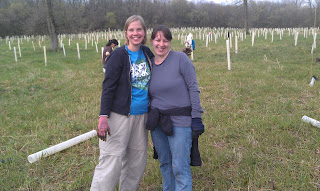At Five Rivers MetroParks we are very busy planting trees. Believe it or not we plan on planting about 80,000 young trees in the MetroParks this spring. This is the first year in a very long time that the agency has done any serious tree planting.
Last weekend trees were planted by volunteers at Carriage Hill and Germantown MetroParks, about 2,500 total. The week before 1000 were planted at Carriage Hill. I know those tubes don't look like trees, they are tree shelters. They protect the little seedlings from rabbits, mice, and especially deer. Without them the survival of the seedlings is very low. The little trees grow inside the transluscent tube. By the time they grow out the top they are too high for the deer to bother with.
The seedlings that the volunteers planted were home grown by MetroParks staff at Cox Arboretum and dozens of committed volunteers. We call this program the Forest Foster Tree Program. Locally collected seeds are germinated at Cox Arboretum, and placed into small tubes. Volunteers take them home for the summer and take care of them. They bring them back in the fall where they are put to bed for the winter.


Yesterday another big tree planting was started at the Medlar Conservation Area south of Miamisburg. They are being planted on a farm MetroParks purchased a few years ago using Clean Ohio grant funds. The grant also covered the cost of paying a contractor to plant 24,000 trees on the old farm fields there. The trees are being planted by the firm Cardno-JF New. The bare root trees were transported to the site in a refrigerated truck. The contractors dip the tree roots in a tub containing wee beasties called micorrhizal fungi to help them grow. Then they load them into buckets on the back of tree planter. A tractor pulls the tree planter and the operator of the tree planter drops the seedlings into a groove in the soil created by the planter. Two small wheels then close the dirt around the new tree. Pretty slick.


The contractors can out-plant the volunteers for sure. But of course, we had to pay them. At least 150 volunteers turned out to help plant the their areas. The smiles on their faces, and the good feelings they got by working to make the world a better place is an intangible benefit that goes way beyond a budget. Who knows, one of those kids could have been inspired to become the next Aldo Leopold!
If anyone wants to help, we sure need it. Just go to www. metroparks.org/forests and sign up. The next scheduled planting is Saturday, March 24 at Carriage Hill MetroPark.















